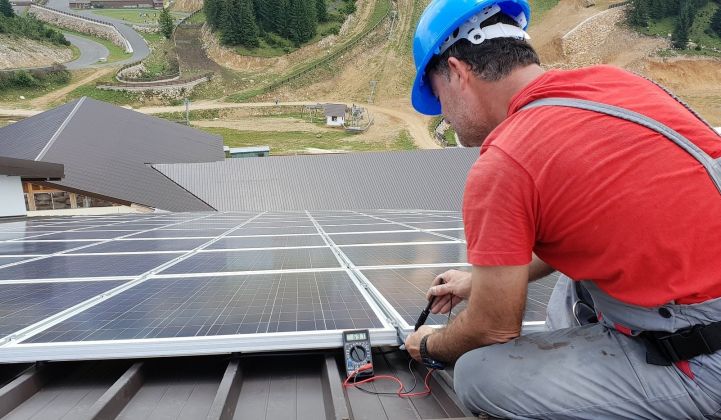Debate continues to simmer in California as to what role community solar projects will play as part of the state's new building codes that require solar installations on all new homes, which went into effect at the start of this year.
Sacramento is ground zero for the tension, as the Sacramento Municipal Utility District (SMUD) works to persuade regulators at the California Energy Commission to approve a program called SolarShares that it considers to be a form of community solar. But the solar industry has pushed back on the SolarShares program, arguing that it would set a poor precedent for the state's largely undeveloped community solar market.
In January, SMUD submitted a new proposal that incorporates some of the changes the solar industry called for: Rather than relying on utility-scale resources, including one project located far away in Fresno County, SMUD will only draw electricity from projects in its service territory; projects for the program will come in under 20 megawatts; the utility will double the savings available to subscribers, from $5 per kilowatt each year in its original proposal to $10 per kilowatt per year; and SMUD will add new resources rather than relying on existing projects.
The commission plans to take up the new proposal at a February 20 meeting. Commission staff have recommended its approval. SMUD’s changes have also gotten some solar and environmental allies on board, including the Coalition for Community Solar Access (CCSA).
“SMUD addressed a lot of the concerns that we raised,” said Charlie Coggeshall, CCSA's policy lead in California and Oregon. “We’re not calling it the gold standard, but at the same time I think it’s hard for us to push back any further just based on the [number] of concessions they made.”
That feeling is not universal within the solar industry, however. Tensions between SMUD and parts of the solar industry were clear at a recent event hosted by the Solar Energy Industries Association (SEIA) and the Smart Electric Power Alliance.
"So much animosity"
Onstage at the event, Wade Hughes, manager of SMUD’s green energy and carbon offset program, claimed that “there’s a lot of debate around what...'community solar' actually means.” But Rick Umoff, SEIA's California director, challenged that assertion, noting that a definition has coalesced around “key attributes” such as distribution-level benefits and additionality — qualities the original SMUD proposal lacked.
“We’re a little concerned that, at least here in California, there has been sort of a blurring of the lines” about what constitutes community solar, Umoff said onstage at the event. After a tense exchange over renewable energy credits, in which Julia Zuckerman, head of external affairs for the West at developer Clearway Energy, also suggested SMUD’s program didn’t meet some of the fundamentals of community solar, the session ended with Hughes lamenting the squabbles over SolarShares.
“It's a shame that there’s been so much animosity,” said Hughes. “It’s a shame that there’s been of late a lack of cooperation [and] a lack of collaboration, and the people we have thought of as our strongest allies somehow find it within themselves to be on the other side.”
Builders in California argue that homebuyers need another option aside from paying for a residential solar system upfront. But the solar industry worries that the approval of a less-than-ideal program could undercut California’s entire community solar market before it even has a chance to take off.
California's community solar market on the line?
The battle over SMUD’s program — which would only apply to the utility’s 1.5 million customers in a state where the three largest investor-owned utilities serve nearly 12 million ratepayers* — reflects broader concerns about the future of California’s community solar market and what role it will play in the state’s ambitious climate and clean energy goals. If SMUD's program is ultimately approved by regulators, similar alternatives are likely to pop up in other parts of the state.
Though California easily ranks atop all states for both distributed and large-scale solar, community solar markets in states such as Minnesota and Massachusetts — with 722 and 328 megawatts in place, respectively — dwarf California’s 144.4 megawatts of installations.
Several solar advocates, including Vote Solar and the Solar Rights Alliance, called for more extensive changes from SMUD in comments submitted to the commission last month.
Specifically, Vote Solar wants SMUD to more directly engage with disadvantaged community groups in its service territory to help make decisions about solar projects. The Center for Biological Diversity, an environmental advocacy group, said the credits associated with the program are “still woefully low” and are not commensurate with the full benefits offered by rooftop solar.
Coggeshall at CCSA said in an ideal world, his organization would like to see further tweaks to SolarShares but observed that additional changes are unlikely. “I don’t think the CEC will have the appetite for that,” he said.
The process to approve the program has already extended beyond the date when the mandate went into effect, leaving homebuilders without an alternative compliance mechanism for now (though many pulled permits before the year began, thus extending their timeline).
Numerous homebuilders and builder organizations have lined up in support of the revised program, along with other municipal utilities, the Northern California Power Agency, the American Institute of Architects (California Council) and the Natural Resources Defense Council.
Correction: This figure has been corrected.




